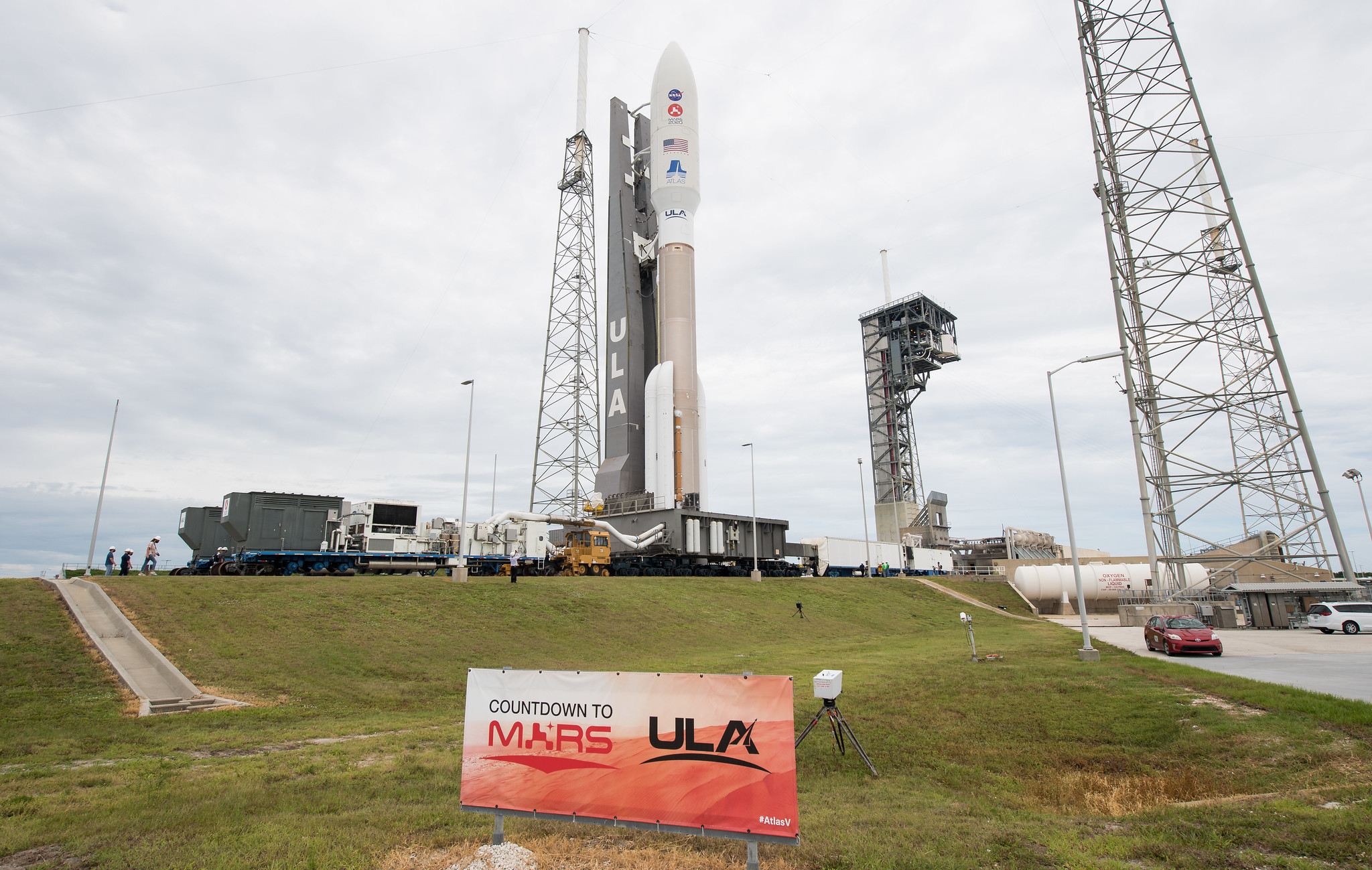NASA's next Mars rover rolls out to launch pad atop Atlas V rocket
The rocket will launch on Thursday, July 30!
CAPE CANAVERAL, Fla. — A United Launch Alliance (ULA) Atlas V rocket rolled to the pad Tuesday (July 28) in preparation for launching NASA's Perseverance rover to Mars.
The mission is scheduled to blast off from Space Launch Complex 41 (SLC-41) at Cape Canaveral Air Force Station during a two-hour window on Thursday (July 30) that opens at 7:50 a.m. EDT (1150 GMT).
The rocket emerged from the Vehicle Integration Facility (VIF) at SLC-41 around 10:30 a.m. EDT (1400 GMT) on Tuesday morning, before completing the first 1,800 feet (548 meters) of its journey to the Red Planet. The gold and white rocket sat perched atop the mobile launch platform; the trek to the launch pad took 35 or 40 minutes, with the rocket pausing for a few short breaks during the journey.
Together, the rocket and spacecraft weigh in at 1.8 million lbs. (820,000 kilograms) and travel to the pad with the help of railcars and trackmobile machines underneath the mobile launch platform. The 200-foot-tall (60 meters) rocket reached the top of the launch pad just after 11 a.m. EDT (1500 GMT) and will sit perched atop the pad until the countdown hits zero on Thursday morning.
Related: How to watch NASA's Mars rover Perseverance launch online
More: NASA's Mars 2020 Perseverance rover: Live updates
When it does take off, the rocket will send NASA's newest Mars rover, dubbed Perseverance, to the Red Planet. The nearly seven-month journey will culminate in an intense landing sequence that will — if all goes well — place the car-sized robot safely in Jezero Crater on Feb. 18, 2021.
The rover will then spend at least one Mars year, or nearly two Earth years, exploring an ancient river delta netled inside Jezero Crater. The site is home to an ancient Martian lake roughly the size of Lake Tahoe on the border between California and Nevada. The river delta is thought to be one of the best places to look for signs of ancient Martian life.
Breaking space news, the latest updates on rocket launches, skywatching events and more!
NASA scientists aren't expecting to find ancient fossils or bones, but instead are looking for evidence left behind by single-celled organisms that could have inhabited the area millions of years ago.
Before the rover can search for such traces, it must launch. To that end, NASA and ULA officials conducted a Launch Readiness Review yesterday (July 27) and determined that the rocket was ready to fly.
"The launch readiness review is complete, and we are indeed go for launch," NASA Administrator Jim Bridenstine said during a news conference yesterday.
The Perseverance Mars rover is safely tucked inside the rocket's nose cone affixed to the top of the vehicle. Flying in the second-most powerful configuration — known as the 541 configuration — the mighty Atlas V will produce 2.3 million lbs. (1 million kg) of thrust at liftoff. That power comes thanks to the vehicle's RD-180 main engine and an added boost from four solid rocket motors attached to the rocket.
"Do not blink [when watching the launch]," ULA CEO Tory Bruno advised during the same news conference yesterday. He went on to explain that the Atlas is going to leap off the pad as it carries a relatively tiny payload.
The preparation for launch began on July 7, when the rover, as well as a small helicopter called Ingenuity, were encapsulated into the payload fairing and stacked on top of the rocket. Ingenuity will attempt to become the first rotorcraft to fly on another planet and will make the long journey to Mars attached to Perseverance's belly plate.
Related: In photos: NASA's Mars Perseverance rover mission to the Red Planet
Engineers then spent two weeks conducting a series of tests to make sure the spacecraft were properly connected to the rocket. Finally, on July 22, the final component was installed: the rover's power source. Perseverance relies on a nuclear-powered generator known as a MMRTG. The specialized fuel source converts heat into electrical energy that will power the rover over its lifetime.
The rover is carrying a sophisticated suite of scientific instruments, more than 20 different cameras and two microphones that will record sound on Mars. All of this equipment earns the Perseverance rover a special superlative — the most advanced robotic explorer NASA has ever sent into deep space.
In addition to conducting a host of science experiments, the rover is charged with collecting samples of Martian dirt and rocks that a future mission will bring back to Earth. Once back on Earth, the Martian samples will be used by scientists for decades to better understand the history of the Red Planet.
Follow Amy Thompson on Twitter @astrogingersnap. Follow us on Twitter @Spacedotcom or Facebook.

Amy Thompson is a Florida-based space and science journalist, who joined Space.com as a contributing writer in 2015. She's passionate about all things space and is a huge science and science-fiction geek. Star Wars is her favorite fandom, with that sassy little droid, R2D2 being her favorite. She studied science at the University of Florida, earning a degree in microbiology. Her work has also been published in Newsweek, VICE, Smithsonian, and many more. Now she chases rockets, writing about launches, commercial space, space station science, and everything in between.

